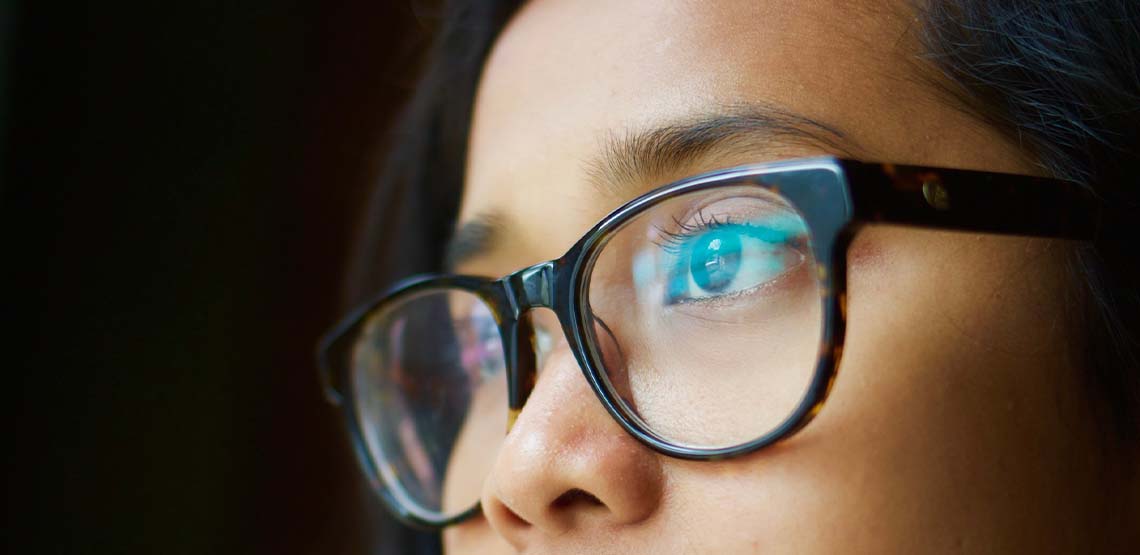Do I Need Glasses?
Everyone’s vision changes as they age. In some cases they eventually need glasses (or other types of treatment such as medication or injections) to continue with their usual day to day activities. Most vision problems are caused by what are known as refractive errors.
Common symptoms of include:
- Blurred or fuzzy vision.
- Distorted vision.
- Double vision.
- Appearance of halos around objects in bright light.
- Difficulty seeing and driving at night.
- Tired, irritated or strained eyes.
- Squinting or frowning.
- Headaches.
Types of Vision Problems Caused by Refractive Errors
In most cases, vision problems are caused by what are known as refractive errors. These happen when the shape of the eye stops you from focusing on images properly and can usually be corrected with glasses, contact lenses or laser eye surgery. Common types of refractive errors include the following.
Nearsightedness
Nearsightedness (myopia) causes faraway objects to appear blurry, while nearby objects can still be seen clearly. This usually happens because the eyeball is too long or because the cornea is curved.
Farsightedness
People with farsightedness (hyperopia) can see faraway objects clearly, but are unable to focus on nearby objects. This is caused either by a short eyeball or an abnormally shaped cornea.
Astigmatism
Astigmatism refers to vision problems that are caused by an abnormally curved cornea. This causes light to fall unevenly on the retina, leading to blurred or distorted vision.
Presbyopia
Presbyopia is an age-related vision problem that can make it difficult to focus on nearby objects. This happens due to natural changes in eye function over time and is usually addressed with reading glasses.
Treatment Options for Vision Problems
If your vision problems are caused by a refractory error, you may use glasses or contact lenses to help you see better. Whether you choose glasses or contacts will often depend on your lifestyle and the situations in which you will need to use them.
Glasses
There are two types of glasses: single vision glasses (which help the wearer to focus on objects far away) and multifocal glasses (which help the wearer to focus on objects both near and far).
Multifocal lenses come in three subtypes, which are:
- Bifocals. Bifocal lenses are divided into two sections; one for seeing over long distances and another for focusing on nearby objects.
- Trifocals. Trifocal lenses are the same as bifocals, but with a third additional section for middle vision.
- Progressive lenses. Progressive lenses do everything bifocals and trifocals do, but with no dividing line between the different sections. This allows for a smoother transition between far, middle and near vision.
If you do decide to get glasses, your ophthalmologist will be able to advise on what type of lens is most suitable for you.
Contact Lenses
Contact lenses can also be used to correct vision problems in people with refractive disorders. These thin, clear, plastic disks are worn over the surface of the eyeball and help the wearer to focus on both far away and nearby objects, just as glasses do. People may choose to use contact lenses if they find that wearing glasses interferes with some aspect of their day to day life (for example, playing sports or cooking).
However, contact lenses require more careful maintenance than glasses and can cause problems if not used with care. Contacts that are not cleaned, disinfected and stored properly can lead to serious eye infections and old or ill-fitting contacts can scratch the surface of the eye.
If you do opt for contacts, make sure you understand the risks and commit to maintaining and replacing them as needed.
Refractive Surgery
In some cases, refractive surgery may be used to reshape the cornea, which improves vision by helping the eye to focus properly. The most common type of refractive surgery is called LASIK (laser-assisted in-situ keratomileusis) and uses lasers to reshape the cornea. You may be a good candidate for refractive surgery if:
- You want to use your glasses or contact lenses less.
- You do not have any other eye diseases.
- You have a refractive error that can be addressed by refractive surgery.
- You understand and accept the potential risks and complications of the surgery.
Vision Problems and Other Illnesses
Sometimes, changes in vision can be a symptom of another, more serious medical condition. Unlike most vision problems (which are usually caused by refractive errors and can be addressed with glasses), eye diseases may require medical or surgical intervention to prevent further vision loss.
The following vision-related symptoms may indicate a more serious illness and should be immediately reported to a doctor:
- Sudden or dramatic changes in vision
- Unusual sensitivity to light
- Seeing bright, floating spots or flashes of light
- Pain in or around the eye (this may be sudden, intense or recurring)
- Changes in the color of the iris or pupil
- A “cup filling with ink” sensation in one eye
- A “curtain coming down” visual effect in one eye
- Sudden “floaters”
- Burning, itching, stinging, red or otherwise inflamed eyes
- Heavy discharge from one or both eyes
Common Medical Causes of Vision Problems
In some cases, vision problems are non-refractory and cannot be corrected with glasses. This is known as low vision and is usually caused by one of the following medical conditions.
Age-related Macular Degeneration
Macular degeneration is a condition in which part of the retina (known as the macula) deteriorates over time. This causes blurred vision and, eventually, blindness. Macular degeneration is usually age-related and is the most common cause of blindness in Caucasian people and those over the age of 65.
Glaucoma
Glaucoma is a condition that causes damage to the optic nerve and may also lead to blindness if left untreated. However, if detected early, vision loss can be minimized with medical or surgical treatment.
Diabetic Retinopathy
People with diabetes are at greater risk of diabetic retinopathy. This condition causes the blood vessels in the retina to grow, tiny abnormal branches. These are very fragile and can leak blood into the eye, causing spotted or blurred vision. If left untreated, the condition can cause serious damage to the retina over time.
Cataracts
Cataracts, a condition in which the lens of the eye gradually hardens and becomes cloudy, is the leading cause of blindness worldwide. Cataract removal treatment is widely available, though the cost of the procedure may be prohibitive for some people.
When to See a Doctor
Even if you notice any changes to your vision, it is a good idea to get regular eye exam from an ophthalmologist. This will help you to monitor and maintain the health of your eyes, just as regular dental checks help to keep your teeth in good shape.
However, if you do notice any changes to your vision, you should schedule an appointment right away, especially if the changes are sudden, dramatic, or accompanied by other symptoms. If you have a family medical history of eye disorders like glaucoma, macular degeneration or cataracts, you may need more frequent eye exams.
In Conclusion
Refractive errors are the most common cause of vision problems and include nearsightedness, farsightedness, astigmatism and presbyopia. Vision problems caused by refractive errors may be related to age (as is the case with presbyopia) or you may be born with them. Most of the time, people use glasses or contact lenses to correct their vision, though many choose to permanently fix their eyesight using refractive surgery.
More rarely, vision problems are caused by eye diseases such as glaucoma, cataracts, age-related macular degeneration or diabetic retinopathy.
Regular eye exams are the best way to maintain the long-term health of your eyes. However, if you notice any sudden changes to your vision, schedule an appointment with an ophthalmologist right away.
Article Resources
- NIH (Refractive Errors)
- MedlinePlus (Refractive Errors)
- Healthline (Do I Need Glasses?)
- WebMD (Contacts vs. Glasses)
- American Academy of Opthalmology (Glasses & Contacts)
- American Academy of Opthalmology (What Is Refractive Surgery?)
- VisionAware (Signs and Symptoms of Vision Problems)
- NCBI (Blindness)
- American Academy of Opthalmology (What Causes Low Vision?)
- NCBI (2Understanding the Epidemiology of Vision Loss and Impairment in the United States)
- CDC (Common Eye Disorders)

